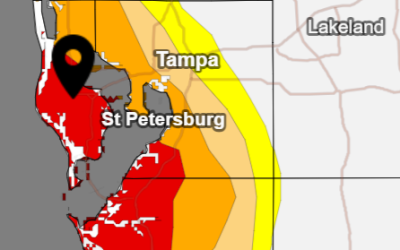Hey guys, welcome back. We’re here again at Bonner Park and we’re going to talk about one of our most iconic important but also kind of misunderstood ecosystems, the mangrove ecosystem.
So, the mangrove ecosystem actually covers about 469,000 acres, mostly in Central and South Florida. And they’re also responsible for providing nursery habitat for about 75% of game fish and also about 90% of commercial fish. So, they’re super important and today we’re going to learn how to identify three of the major ones that you’ll find in our area.
Mangroves
Mangroves live and thrive in a saltwater environment, which means that each of the species are adapted a unique strategy to dealing with the salt water.
Red mangrove is a salt excluder, which means it prevents a saltwater from getting into its roots in the first place through membranes.
The black mangrove and the white mangrove both excrete the saltwater through glands on their leaves. These different adapted strategies make the mangrove one of the most unique plants in the world and that it can thrive in these very salient environments.
Red Mangrove
Red mangrove or Rhizophora mangle is one of the most easy to identify of the three mangrove species that we’re going to be talking about today. The reason being is that it’s going to occur closest to the shore where it’s an very silty, mucky and low oxygen content soil. So some of the adaptions that it’s made to this type of environment is it has what are called prop roots, which also has a popular nickname of the walking mangroves because it looks like it’s actually walking out into the shore, so that helps stabilize it.
In addition to that, it has what we call aerial roots, so these are roots that hang down from the trunk and the stem and that helps to actually bring oxygen into the plant. Another way that we identify all these mangroves is by their unique leaf characteristics.
Red mangrove has a very shiny and smooth, dark green upper side with a dark yellow vein, pretty pronounced vein on the underside. It’s a very light, a light green to it, so luckily this time of the year we have developing fruits on it. I want to talk a little bit about what makes these fruits so unique on mangroves.
All mangroves are what we call viviparous and viviparous means they bear live young. When the flower gets germinated on the mangroves, the entire plant begins to develop while still attached to the parent tree. When it does reach maturity, it drops off and I’m sure everybody has seen those long water called propagules that have washed up on the beach, different tidal areas, coastal areas, those are baby seedling mangroves, the red one being the most easy to identify because it’s the largest and you’ll see them floating everywhere. So we can see here, we actually have some developing right now, so you can see what’s left of the flower. And a red mango flower is a yellowish flower blooming in spring and summer. And this is the new mangrove that’s developing from here. So, this has some time to go before it’s going to be mature enough to drop off and carry on a new generation of mangroves.
Black Mangroves
So here we’ve got black mangroves. This is avicennia germinans and you’ll typically see them growing in with the red mangroves. But they will also be more Upland. I’m one of the most identifying characteristics, if you look down in here amongst all the red mangrove prop roots are what are called pneumatophores.
Sometimes you’ll hear them called a dead man’s fingers and they are little structures that come off of the root that will help aerate the plant. So aside from that, we’ve got a fairly simple leaf elliptical in shape and underneath it’s got a little bit of pubescence on it, a little bit of grayish pubescent. The veins are a little bit more pronounced than the red mangroves and they will also kind of admit a little bit of a sheen. And that is actually the salt water being extruded from the leaves. So right now, we’re going to head a little bit back and we’re going to check out the white mangroves.
White Mangroves
Now that we’ve worked our way up from the red mangrove being closest to the shore, to the black mangrove, this is where we’re going to find our next mangrove, which is the white mangrove laguncularia racemosa.
So, one of the easiest ways to identify this one is that it will be the furthest away from the shore. Also, the leaves here, have a very unique and obvious circular portion to them, much wider at the top and the bottom are both very similar in coloration. It also does have that yellow vein going across the center.
The thing that’s really unique about these white ones is that if you notice on each and every one of the petals, which is this portion that comes off of the stem and attaches to the leaf, there’s two nubs. These knobs are called nectarines and they actually excrete sugar. They don’t excrete the salt white mangroves like the black mangroves do excrete salt, but that’s through their roots and other portions on the leaf.
Whereas these nubs were originally thought to excrete salt, they actually excrete a sugary substance, which some scientists think is actually meant to attract a certain type of insects that help the plant. So that’s one of the most unique features and characteristics of this white mangrove. It’s also the least cold tolerant.
So, you won’t find it further North where we have a small scattering of black and red mangroves, for example, in the panhandle and small sections. So furthermore, there is a species of tree called the Buttonwood silver and green Buttonwood. We don’t have any available here at this park to show you, but that’s also considered the fourth mangrove, even though it’s not officially in this type of mangrove ecosystem inundated with saltwater, you’re going to find that furthest back and they do occur along with these other three species of mangroves. So you might be thinking of how you could potentially use some of these mangrove species and your own yard or habitat. Generally right now, red mangrove is the only one that’s commercially available.
It can actually be used and freshwater, which is the interesting thing about all of these plants is they don’t necessarily need saltwater, but they can tolerate it. But we’ve had some awesome customers come through the years who have used red mangroves in ponds different types of aquarium setups or even just planting in different areas of their yard. So red mangrove, we do have available generally with a white and black mangroves, you’re going to have to go through a more of a restoration oriented company. But red mangrove can be used in the landscape and definitely our buttonwoods, which we’ll cover in later episodes.
So, our mangroves are super important part of our coastal systems and they’re also really unique and complex plants that are really cool to learn about.



